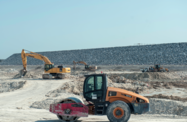The Qatari construction sector is seeing renewed demand, stimulated by major projects linked to the FIFA 2022 World Cup. The building of stadiums and other projects should provide new opportunities for companies in the industry, which has seen increased competition and higher costs in recent years.
Winning the right to host the World Cup has helped accelerate the country’s long-term infrastructure development programme, which includes a metro and light rail system, railways linking to a regional network, and improvements to the road system. It has also added momentum to the ongoing expansion of Qatar’s hotel capacity.
Construction on stadiums for the World Cup, for example, will commence in 2013, following a deal signed by the Qatar 2022 Supreme Committee and several major institutions, including developer Qatari Diar, Ashgal (the public works authority) and Qatar Rail, local press reported in mid-October. During the World Cup, 12 stadiums will be used; nine will be new and three existing grounds will be expanded.
The full schedule for the construction work has yet to be announced, and will be confirmed after consultation with FIFA, the international football association. Development of five of the stadiums is currently under planning or tender, with announcements on the other projects expected soon. There is also an increasing focus on ensuring that the buildings and utilities to be used during the World Cup are environmentally friendly. In October, the local press reported that the Qatar Green Building Council (QGBC) had created a group to work on ensuring that existing and planned hotels meet green standards, including reducing carbon dioxide emissions and increasing waste recycling.
With the environment high on the national agenda, offering green construction options gives developers and contractors an edge in a very competitive market, according to Yousef Al Horr, the founder and chairman of the Gulf Organisation of Research and Development.
“In order to stay attractive, developers are more inclined to adopt sustainable practices,” he told OBG. “The awareness of the public has grown significantly in recent years, whereas three years ago developers really did not pay much attention to sustainable and green building practices, as demand was high. Now the dynamics are different, and there is an oversupply in some areas.”
Green or otherwise, the authorities’ moves to push on with World Cup-linked projects should come as a fillip to the construction sector, which has seen activity fall from the highs of the past decade, largely due to the international economic crisis, and a degree of oversupply in some sectors.
The strong growth of the sector in past years has also drawn in a range of international players, as well as encouraged the growth of domestic firms, many of which have varying experience in handling large projects. Some of these operators compete largely on cost and have led to contract prices being kept down.
Meanwhile, demand for construction materials, coming up against supply bottlenecks and rising international commodity costs, have led to input prices rising. An October report by MEED, a business intelligence firm, suggested that Qatar has the Gulf’s highest costs for construction materials. The third-quarter report states that construction materials cost on average 12% more than in the UAE and 4.5% more than in Saudi Arabia. For example, the average cost of rebar steel is 32% higher in Qatar than in the UAE, while concrete is 26.8% higher. MEED cited the strong pull effect of World Cup construction as the main reason for the higher prices.
The squeeze on contractors’ profits that has resulted made for hard going in the slower years of 2009-10, and continues to have an effect, but the hope now is that progress on long-term projects – and possibly the shaking out of competitors with lower capacity – will provide new room for construction firms to grow.
Meanwhile, demand has also picked up in the private sector. On October 23, the local press reported that Arabtec, the major contractor on the Al Waab City development, would be re-launching construction on the project by November 1, with the first units due to be completed by July 2013. Al Waab is one of Qatar’s biggest private real estate developments, with more than 200 luxury villas.
Private demand is expected to further accelerate over the next two years, as excess property capacity is taken up and the economy continues to grow. Over the medium-to-long term, a healthy balance of big-ticket government projects and private sector development should help provide opportunities for contractors, thus easing the pressure felt in recent years.

